AHMI1643 Assessment 1: Questioning - Research Process and Data
VerifiedAdded on 2023/01/13
|16
|2035
|81
Homework Assignment
AI Summary
This document is a completed written assessment on the research process, undertaken by a student named Gurpal Singh with student ID AHMI1643. The assessment covers key aspects of the research process, including the steps involved, audience understanding, and the creation of a research outline. It defines primary, secondary, and tertiary sources of information. The assessment also explores the importance of pilot studies and pre-data collection planning. Furthermore, it delves into the concepts of qualitative data, qualitative data analysis, and its purpose, along with the definition of annotating. The student has provided detailed answers to all the questions, demonstrating an understanding of the research methodology and data analysis concepts.

Assessment 1 – Questioning – Written Assessment
Student Name Gurpal Singh Student ID Number AHMI1643
Unit Start Date Unit End Date
Assessment Due
Date Date Submitted
This cover sheet is to be completed by the student and assessor and used as a record to
determine student competency in this assessment task
The assessment process and tasks were fully explained. Yes / No
I am aware of which evidence will be collected and how. Yes / No
I am aware of my right to appeal an assessment decision. Yes / No
I am aware that I can locate the RTO’s Complaints and Appeals Policy and
Procedure on their website at (insert website address)
Yes / No
I have discussed any additional educational support or reasonable adjustments I
require in order to undertake this assessment with the Student Support Services
Officer and Trainer / Assessor, (if applicable). e.g. Student Handbook and Access
and Equity Policy (insert website address)
Yes / No
I have access to all required resources? Yes / No
Cheating & Plagiarism Declaration
Student Declaration: In accordance with the RTO’s Plagiarism Policy, I hereby acknowledge
by signing this declaration that I have not cheated or plagiarised any work regarding the
assessment tasks undertaken in this unit of competency except where the work has been
correctly acknowledged.
NOTE: Student must sign this prior to submitting their assessments to the assessor
Signature Gurpal Singh Date
:
______ / ______ /
20______
Page 1 of 16
Student Name Gurpal Singh Student ID Number AHMI1643
Unit Start Date Unit End Date
Assessment Due
Date Date Submitted
This cover sheet is to be completed by the student and assessor and used as a record to
determine student competency in this assessment task
The assessment process and tasks were fully explained. Yes / No
I am aware of which evidence will be collected and how. Yes / No
I am aware of my right to appeal an assessment decision. Yes / No
I am aware that I can locate the RTO’s Complaints and Appeals Policy and
Procedure on their website at (insert website address)
Yes / No
I have discussed any additional educational support or reasonable adjustments I
require in order to undertake this assessment with the Student Support Services
Officer and Trainer / Assessor, (if applicable). e.g. Student Handbook and Access
and Equity Policy (insert website address)
Yes / No
I have access to all required resources? Yes / No
Cheating & Plagiarism Declaration
Student Declaration: In accordance with the RTO’s Plagiarism Policy, I hereby acknowledge
by signing this declaration that I have not cheated or plagiarised any work regarding the
assessment tasks undertaken in this unit of competency except where the work has been
correctly acknowledged.
NOTE: Student must sign this prior to submitting their assessments to the assessor
Signature Gurpal Singh Date
:
______ / ______ /
20______
Page 1 of 16
Paraphrase This Document
Need a fresh take? Get an instant paraphrase of this document with our AI Paraphraser
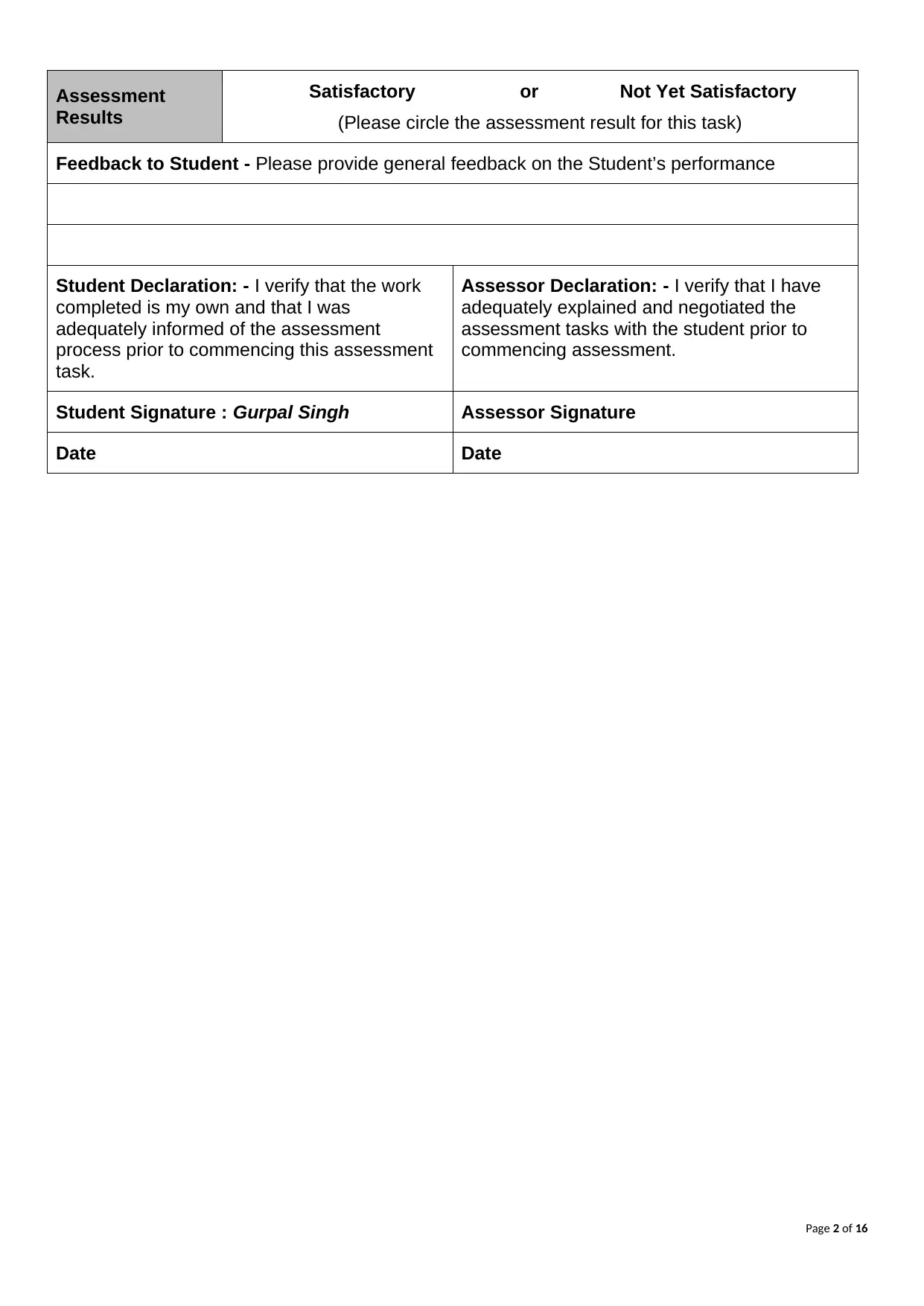
Assessment
Results
Satisfactory or Not Yet Satisfactory
(Please circle the assessment result for this task)
Feedback to Student - Please provide general feedback on the Student’s performance
Student Declaration: - I verify that the work
completed is my own and that I was
adequately informed of the assessment
process prior to commencing this assessment
task.
Assessor Declaration: - I verify that I have
adequately explained and negotiated the
assessment tasks with the student prior to
commencing assessment.
Student Signature : Gurpal Singh Assessor Signature
Date Date
Page 2 of 16
Results
Satisfactory or Not Yet Satisfactory
(Please circle the assessment result for this task)
Feedback to Student - Please provide general feedback on the Student’s performance
Student Declaration: - I verify that the work
completed is my own and that I was
adequately informed of the assessment
process prior to commencing this assessment
task.
Assessor Declaration: - I verify that I have
adequately explained and negotiated the
assessment tasks with the student prior to
commencing assessment.
Student Signature : Gurpal Singh Assessor Signature
Date Date
Page 2 of 16
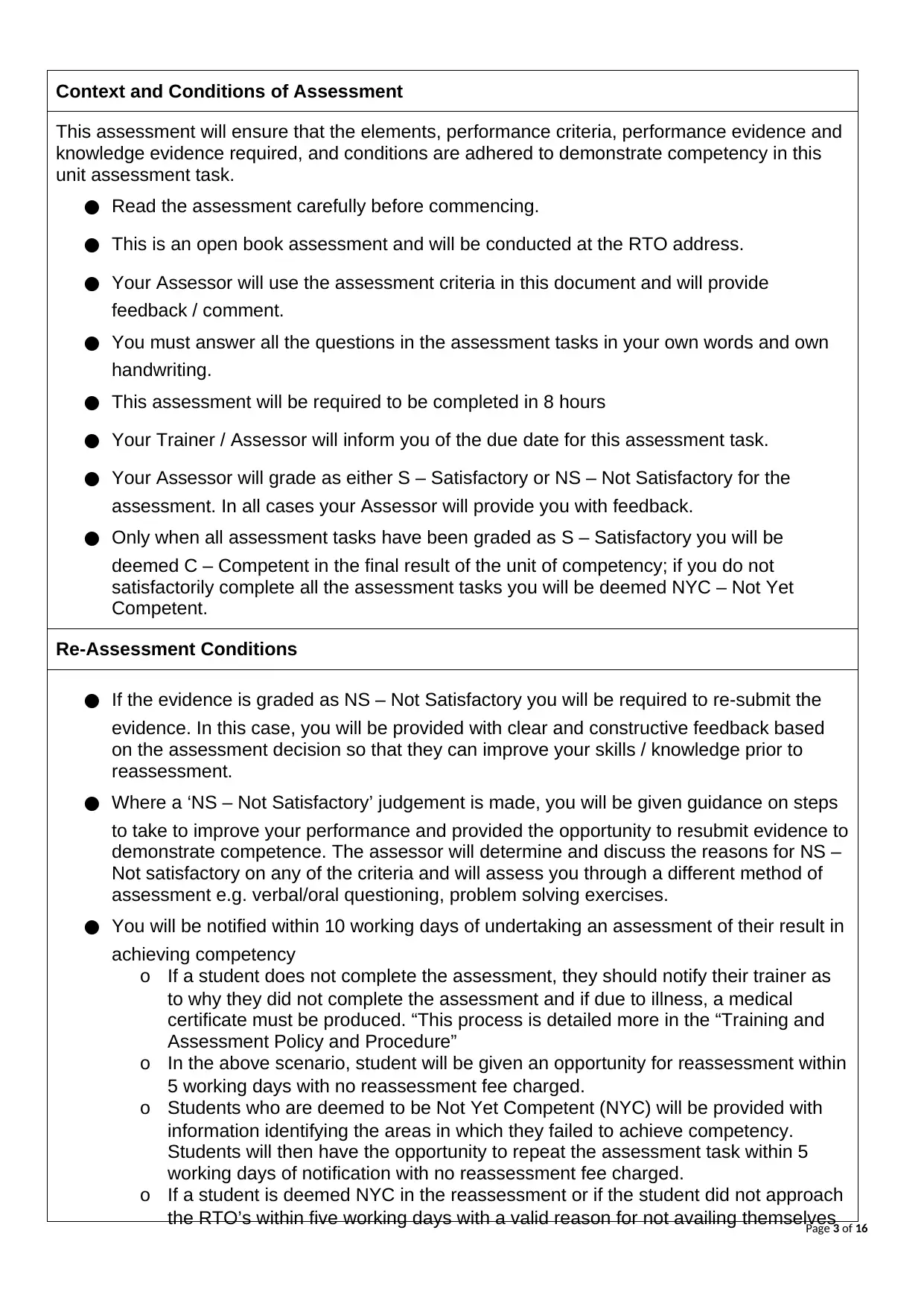
Context and Conditions of Assessment
This assessment will ensure that the elements, performance criteria, performance evidence and
knowledge evidence required, and conditions are adhered to demonstrate competency in this
unit assessment task.
● Read the assessment carefully before commencing.
● This is an open book assessment and will be conducted at the RTO address.
● Your Assessor will use the assessment criteria in this document and will provide
feedback / comment.
● You must answer all the questions in the assessment tasks in your own words and own
handwriting.
● This assessment will be required to be completed in 8 hours
● Your Trainer / Assessor will inform you of the due date for this assessment task.
● Your Assessor will grade as either S – Satisfactory or NS – Not Satisfactory for the
assessment. In all cases your Assessor will provide you with feedback.
● Only when all assessment tasks have been graded as S – Satisfactory you will be
deemed C – Competent in the final result of the unit of competency; if you do not
satisfactorily complete all the assessment tasks you will be deemed NYC – Not Yet
Competent.
Re-Assessment Conditions
● If the evidence is graded as NS – Not Satisfactory you will be required to re-submit the
evidence. In this case, you will be provided with clear and constructive feedback based
on the assessment decision so that they can improve your skills / knowledge prior to
reassessment.
● Where a ‘NS – Not Satisfactory’ judgement is made, you will be given guidance on steps
to take to improve your performance and provided the opportunity to resubmit evidence to
demonstrate competence. The assessor will determine and discuss the reasons for NS –
Not satisfactory on any of the criteria and will assess you through a different method of
assessment e.g. verbal/oral questioning, problem solving exercises.
● You will be notified within 10 working days of undertaking an assessment of their result in
achieving competency
o If a student does not complete the assessment, they should notify their trainer as
to why they did not complete the assessment and if due to illness, a medical
certificate must be produced. “This process is detailed more in the “Training and
Assessment Policy and Procedure”
o In the above scenario, student will be given an opportunity for reassessment within
5 working days with no reassessment fee charged.
o Students who are deemed to be Not Yet Competent (NYC) will be provided with
information identifying the areas in which they failed to achieve competency.
Students will then have the opportunity to repeat the assessment task within 5
working days of notification with no reassessment fee charged.
o If a student is deemed NYC in the reassessment or if the student did not approach
the RTO’s within five working days with a valid reason for not availing themselvesPage 3 of 16
This assessment will ensure that the elements, performance criteria, performance evidence and
knowledge evidence required, and conditions are adhered to demonstrate competency in this
unit assessment task.
● Read the assessment carefully before commencing.
● This is an open book assessment and will be conducted at the RTO address.
● Your Assessor will use the assessment criteria in this document and will provide
feedback / comment.
● You must answer all the questions in the assessment tasks in your own words and own
handwriting.
● This assessment will be required to be completed in 8 hours
● Your Trainer / Assessor will inform you of the due date for this assessment task.
● Your Assessor will grade as either S – Satisfactory or NS – Not Satisfactory for the
assessment. In all cases your Assessor will provide you with feedback.
● Only when all assessment tasks have been graded as S – Satisfactory you will be
deemed C – Competent in the final result of the unit of competency; if you do not
satisfactorily complete all the assessment tasks you will be deemed NYC – Not Yet
Competent.
Re-Assessment Conditions
● If the evidence is graded as NS – Not Satisfactory you will be required to re-submit the
evidence. In this case, you will be provided with clear and constructive feedback based
on the assessment decision so that they can improve your skills / knowledge prior to
reassessment.
● Where a ‘NS – Not Satisfactory’ judgement is made, you will be given guidance on steps
to take to improve your performance and provided the opportunity to resubmit evidence to
demonstrate competence. The assessor will determine and discuss the reasons for NS –
Not satisfactory on any of the criteria and will assess you through a different method of
assessment e.g. verbal/oral questioning, problem solving exercises.
● You will be notified within 10 working days of undertaking an assessment of their result in
achieving competency
o If a student does not complete the assessment, they should notify their trainer as
to why they did not complete the assessment and if due to illness, a medical
certificate must be produced. “This process is detailed more in the “Training and
Assessment Policy and Procedure”
o In the above scenario, student will be given an opportunity for reassessment within
5 working days with no reassessment fee charged.
o Students who are deemed to be Not Yet Competent (NYC) will be provided with
information identifying the areas in which they failed to achieve competency.
Students will then have the opportunity to repeat the assessment task within 5
working days of notification with no reassessment fee charged.
o If a student is deemed NYC in the reassessment or if the student did not approach
the RTO’s within five working days with a valid reason for not availing themselvesPage 3 of 16
⊘ This is a preview!⊘
Do you want full access?
Subscribe today to unlock all pages.

Trusted by 1+ million students worldwide

Page 4 of 16
Paraphrase This Document
Need a fresh take? Get an instant paraphrase of this document with our AI Paraphraser
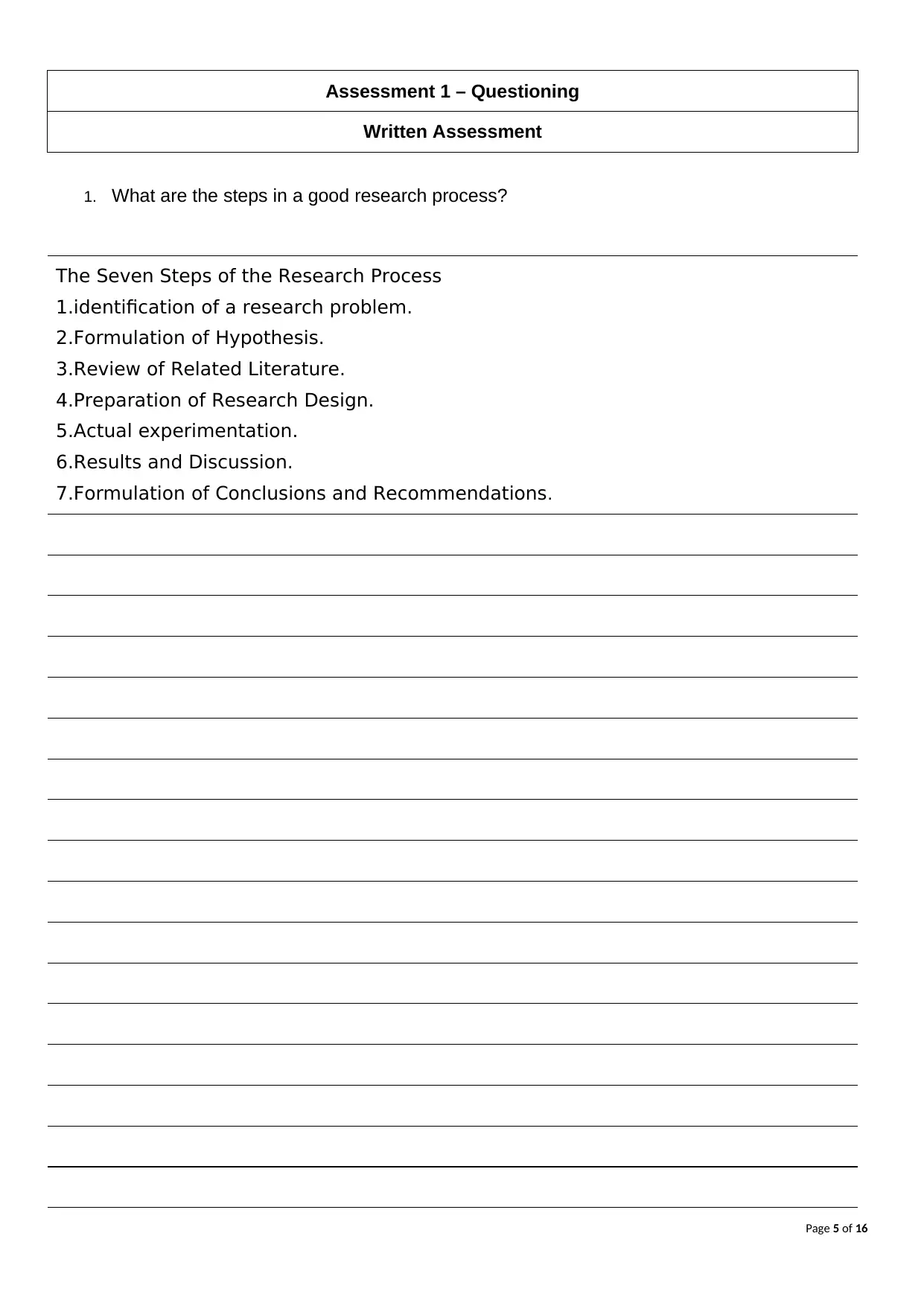
Assessment 1 – Questioning
Written Assessment
1. What are the steps in a good research process?
The Seven Steps of the Research Process
1.identification of a research problem.
2.Formulation of Hypothesis.
3.Review of Related Literature.
4.Preparation of Research Design.
5.Actual experimentation.
6.Results and Discussion.
7.Formulation of Conclusions and Recommendations.
Page 5 of 16
Written Assessment
1. What are the steps in a good research process?
The Seven Steps of the Research Process
1.identification of a research problem.
2.Formulation of Hypothesis.
3.Review of Related Literature.
4.Preparation of Research Design.
5.Actual experimentation.
6.Results and Discussion.
7.Formulation of Conclusions and Recommendations.
Page 5 of 16
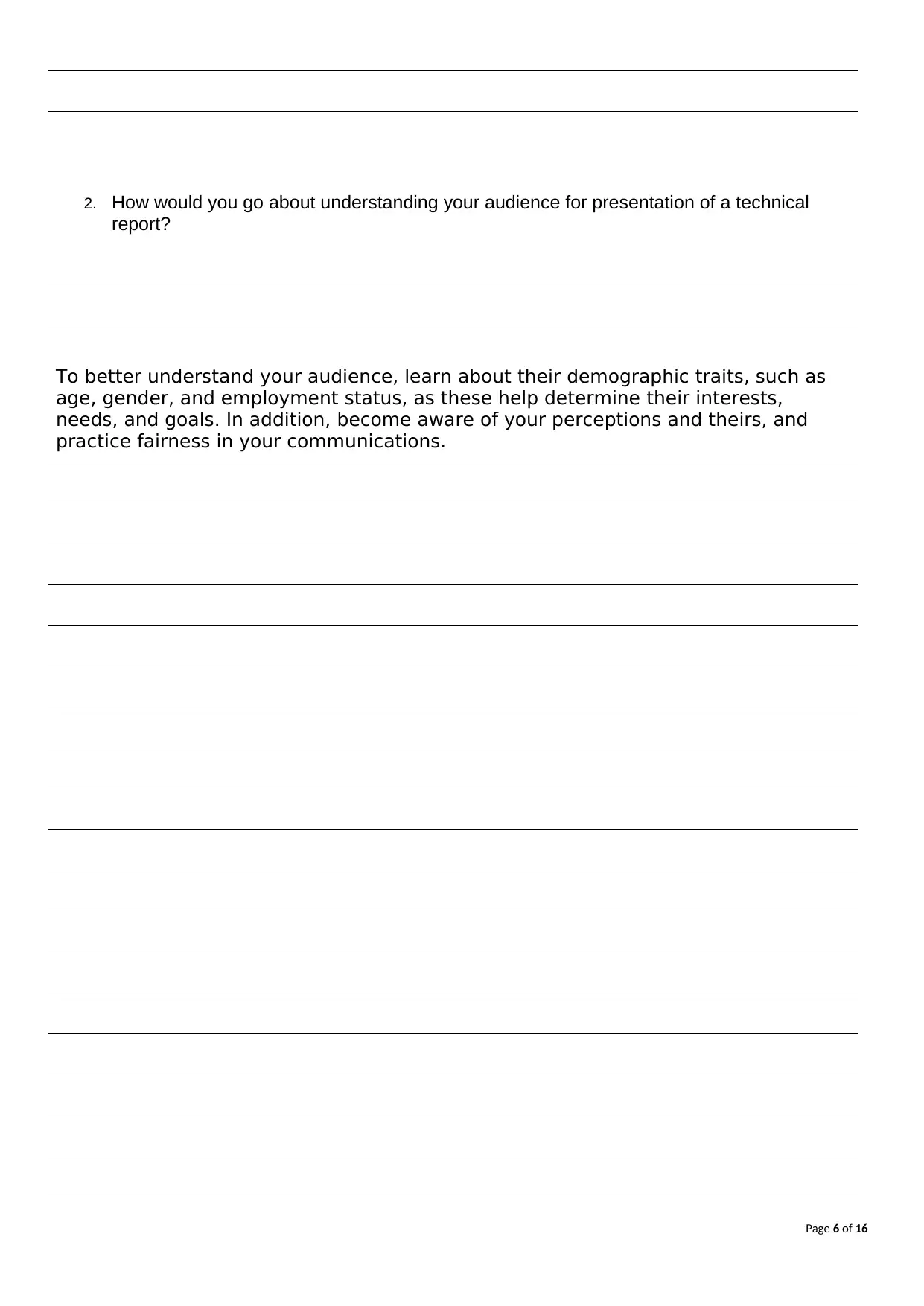
2. How would you go about understanding your audience for presentation of a technical
report?
To better understand your audience, learn about their demographic traits, such as
age, gender, and employment status, as these help determine their interests,
needs, and goals. In addition, become aware of your perceptions and theirs, and
practice fairness in your communications.
Page 6 of 16
report?
To better understand your audience, learn about their demographic traits, such as
age, gender, and employment status, as these help determine their interests,
needs, and goals. In addition, become aware of your perceptions and theirs, and
practice fairness in your communications.
Page 6 of 16
⊘ This is a preview!⊘
Do you want full access?
Subscribe today to unlock all pages.

Trusted by 1+ million students worldwide
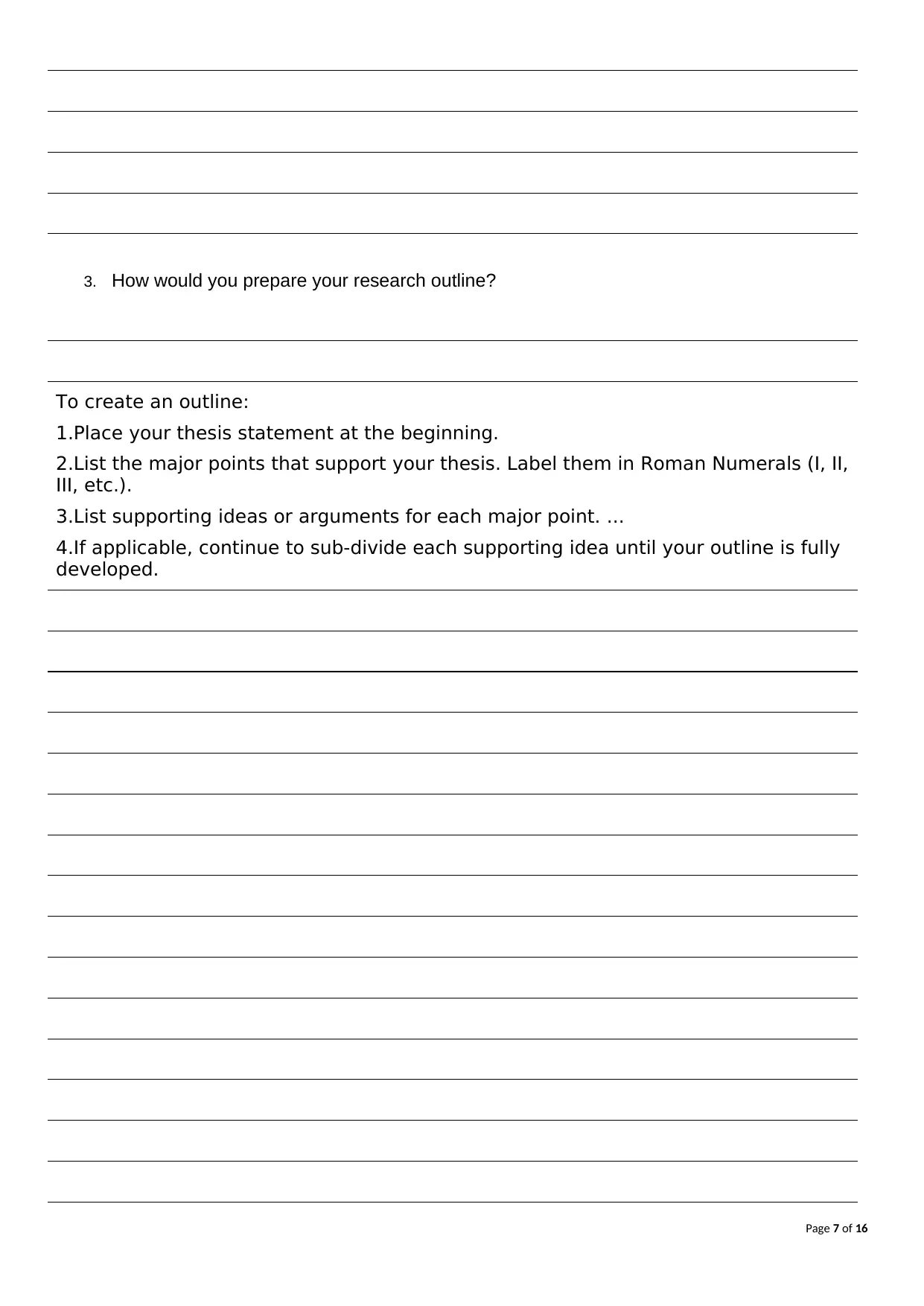
3. How would you prepare your research outline?
To create an outline:
1.Place your thesis statement at the beginning.
2.List the major points that support your thesis. Label them in Roman Numerals (I, II,
III, etc.).
3.List supporting ideas or arguments for each major point. ...
4.If applicable, continue to sub-divide each supporting idea until your outline is fully
developed.
Page 7 of 16
To create an outline:
1.Place your thesis statement at the beginning.
2.List the major points that support your thesis. Label them in Roman Numerals (I, II,
III, etc.).
3.List supporting ideas or arguments for each major point. ...
4.If applicable, continue to sub-divide each supporting idea until your outline is fully
developed.
Page 7 of 16
Paraphrase This Document
Need a fresh take? Get an instant paraphrase of this document with our AI Paraphraser

4. In general, there are three types of resources or sources of information: primary,
secondary, and tertiary. Define each of these.
Primary sources are created as close to the original event or phenomenon as it is
possible to be. For example, a photograph or video of an event is a primary source.
Data from an experiment is a primary source.
Secondary sources are one step removed from that. Secondary sources are based
on or about the primary sources. For example, articles and books in which authors
interpret data from another research team's experiment or archival footage of an
event are usually considered secondary sources.
Tertiary sources are one further step removed from that. Tertiary sources
summarize or synthesize the research in secondary sources. For example, textbooks
and reference books are tertiary sources.
Page 8 of 16
secondary, and tertiary. Define each of these.
Primary sources are created as close to the original event or phenomenon as it is
possible to be. For example, a photograph or video of an event is a primary source.
Data from an experiment is a primary source.
Secondary sources are one step removed from that. Secondary sources are based
on or about the primary sources. For example, articles and books in which authors
interpret data from another research team's experiment or archival footage of an
event are usually considered secondary sources.
Tertiary sources are one further step removed from that. Tertiary sources
summarize or synthesize the research in secondary sources. For example, textbooks
and reference books are tertiary sources.
Page 8 of 16
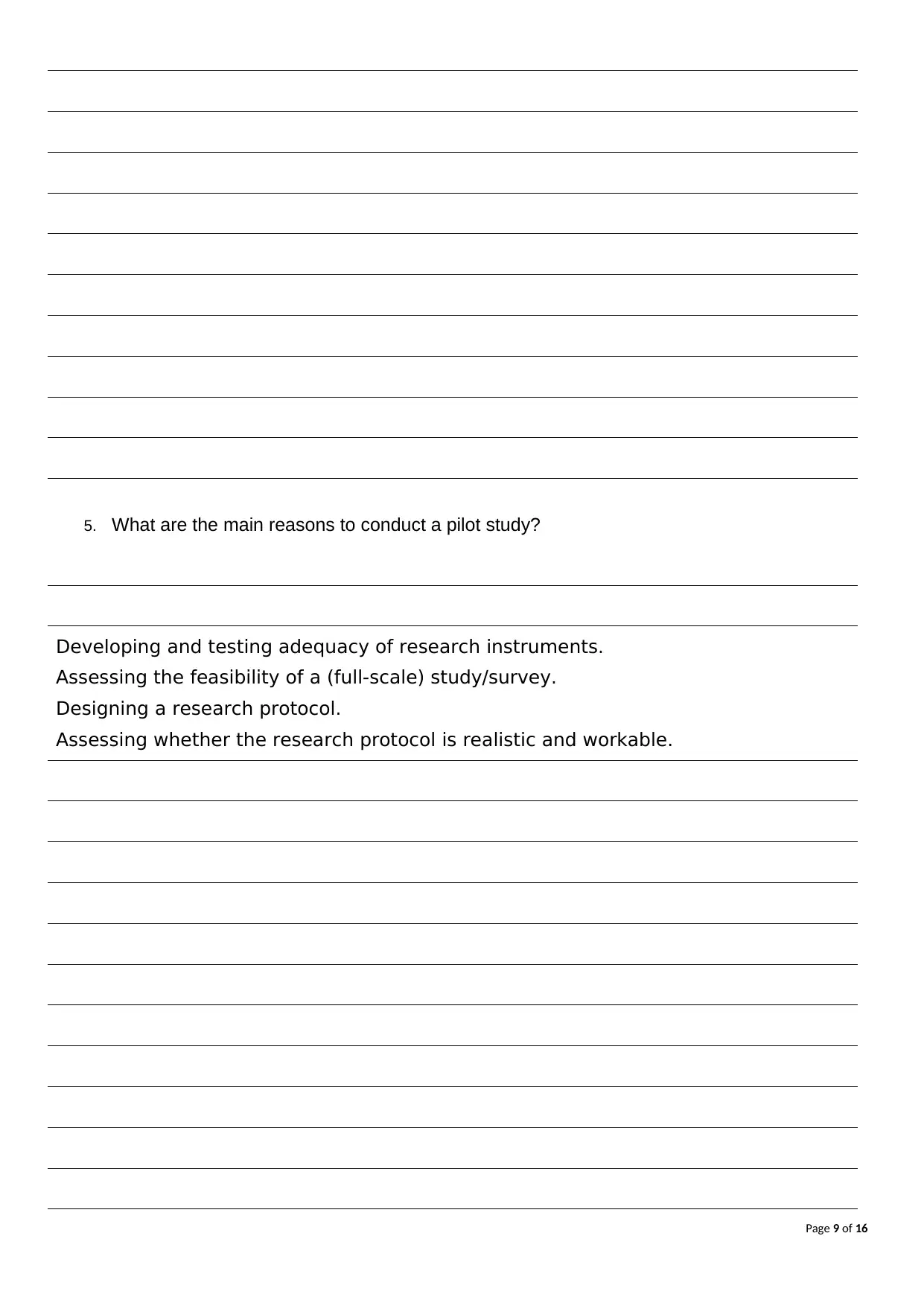
5. What are the main reasons to conduct a pilot study?
Developing and testing adequacy of research instruments.
Assessing the feasibility of a (full-scale) study/survey.
Designing a research protocol.
Assessing whether the research protocol is realistic and workable.
Page 9 of 16
Developing and testing adequacy of research instruments.
Assessing the feasibility of a (full-scale) study/survey.
Designing a research protocol.
Assessing whether the research protocol is realistic and workable.
Page 9 of 16
⊘ This is a preview!⊘
Do you want full access?
Subscribe today to unlock all pages.

Trusted by 1+ million students worldwide
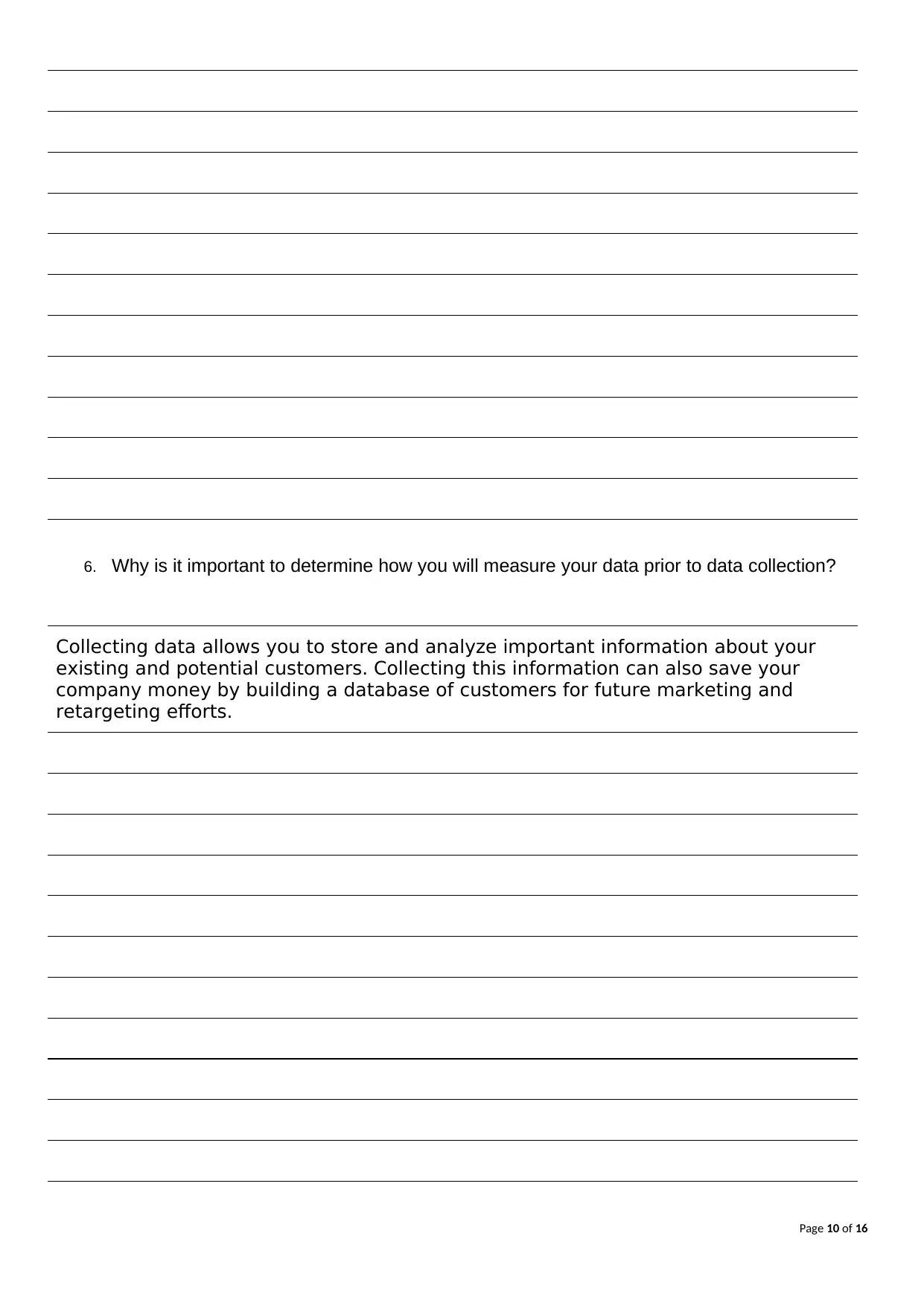
6. Why is it important to determine how you will measure your data prior to data collection?
Collecting data allows you to store and analyze important information about your
existing and potential customers. Collecting this information can also save your
company money by building a database of customers for future marketing and
retargeting efforts.
Page 10 of 16
Collecting data allows you to store and analyze important information about your
existing and potential customers. Collecting this information can also save your
company money by building a database of customers for future marketing and
retargeting efforts.
Page 10 of 16
Paraphrase This Document
Need a fresh take? Get an instant paraphrase of this document with our AI Paraphraser
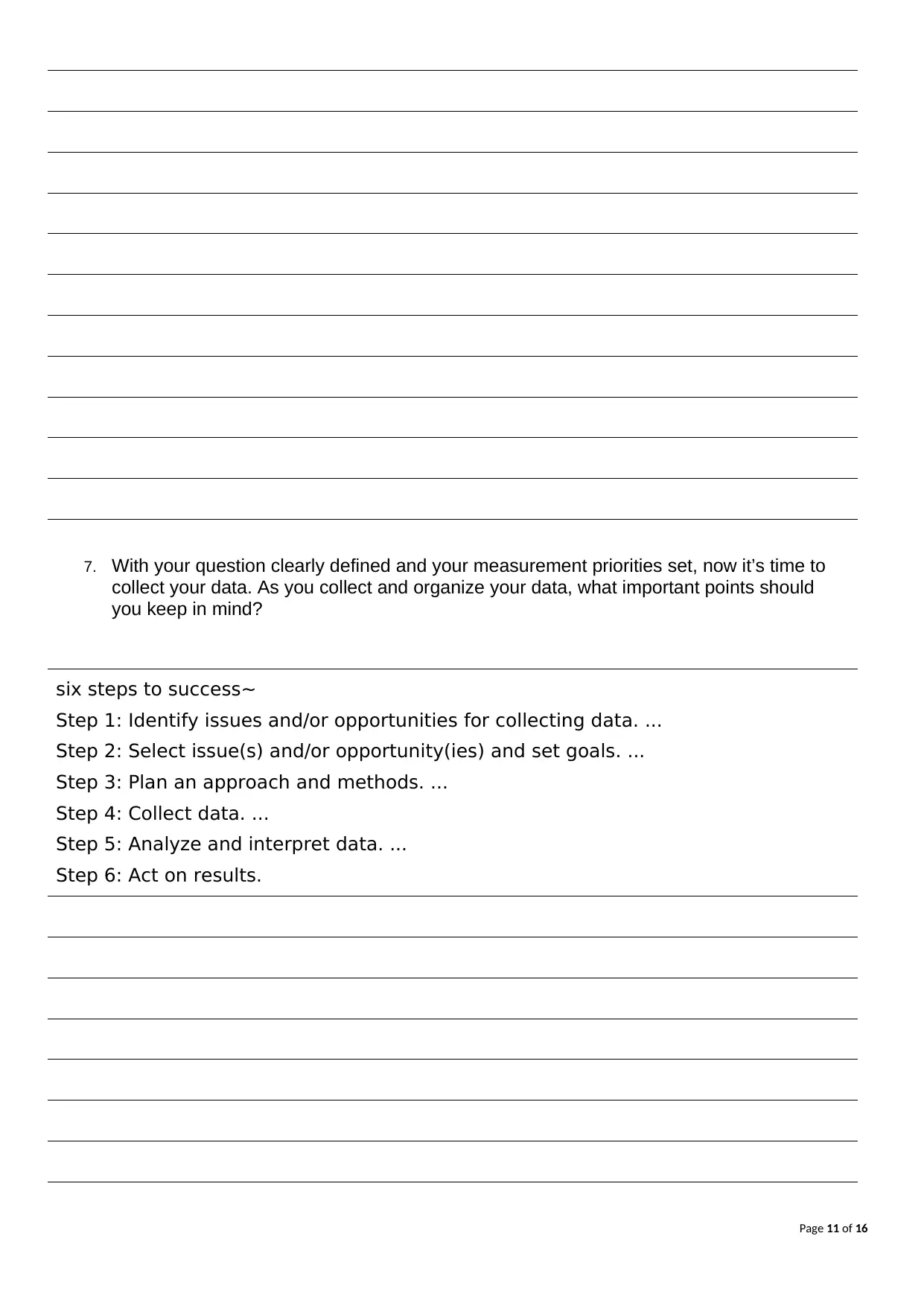
7. With your question clearly defined and your measurement priorities set, now it’s time to
collect your data. As you collect and organize your data, what important points should
you keep in mind?
six steps to success~
Step 1: Identify issues and/or opportunities for collecting data. ...
Step 2: Select issue(s) and/or opportunity(ies) and set goals. ...
Step 3: Plan an approach and methods. ...
Step 4: Collect data. ...
Step 5: Analyze and interpret data. ...
Step 6: Act on results.
Page 11 of 16
collect your data. As you collect and organize your data, what important points should
you keep in mind?
six steps to success~
Step 1: Identify issues and/or opportunities for collecting data. ...
Step 2: Select issue(s) and/or opportunity(ies) and set goals. ...
Step 3: Plan an approach and methods. ...
Step 4: Collect data. ...
Step 5: Analyze and interpret data. ...
Step 6: Act on results.
Page 11 of 16
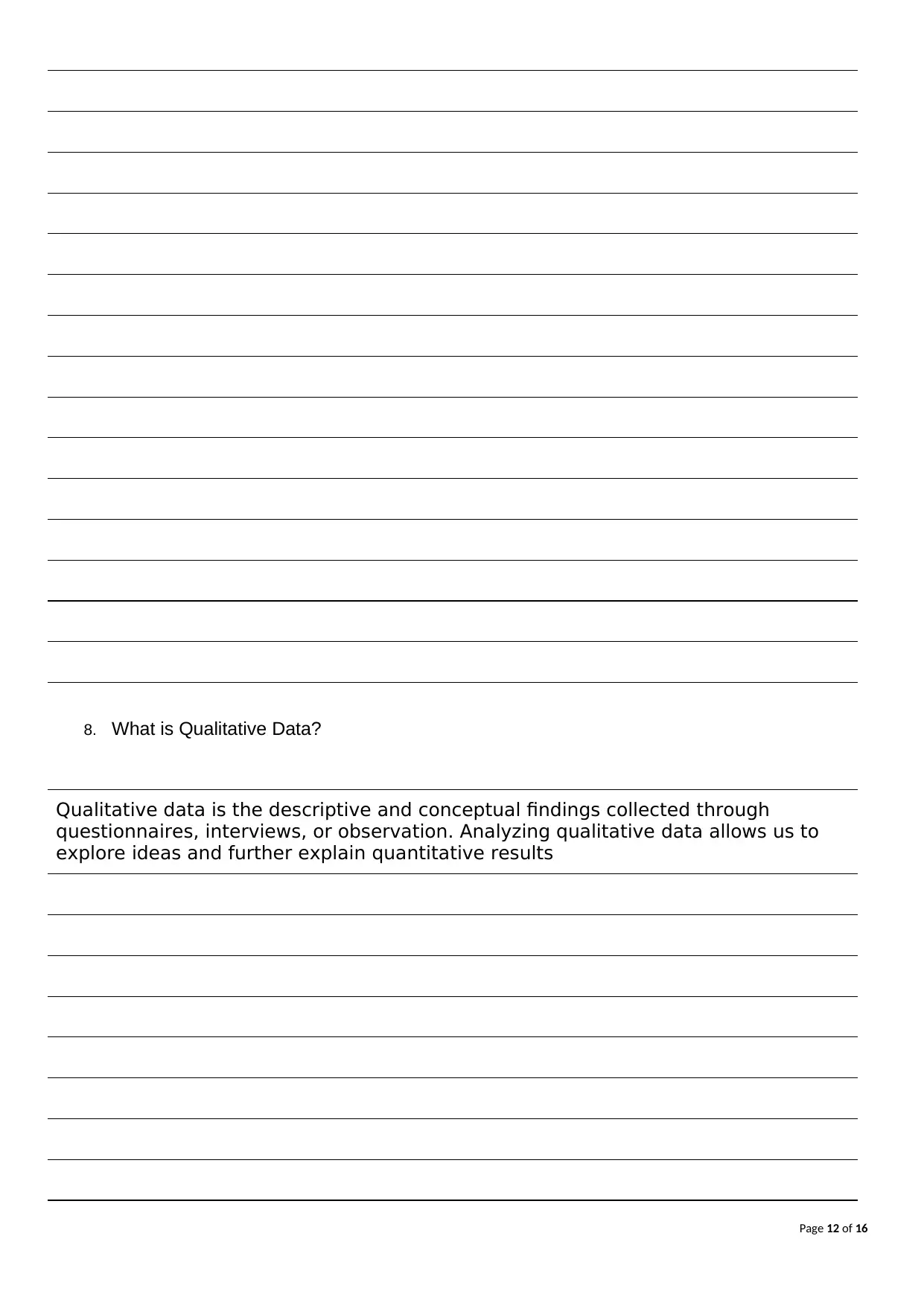
8. What is Qualitative Data?
Qualitative data is the descriptive and conceptual findings collected through
questionnaires, interviews, or observation. Analyzing qualitative data allows us to
explore ideas and further explain quantitative results
Page 12 of 16
Qualitative data is the descriptive and conceptual findings collected through
questionnaires, interviews, or observation. Analyzing qualitative data allows us to
explore ideas and further explain quantitative results
Page 12 of 16
⊘ This is a preview!⊘
Do you want full access?
Subscribe today to unlock all pages.

Trusted by 1+ million students worldwide
1 out of 16
Related Documents
Your All-in-One AI-Powered Toolkit for Academic Success.
+13062052269
info@desklib.com
Available 24*7 on WhatsApp / Email
![[object Object]](/_next/static/media/star-bottom.7253800d.svg)
Unlock your academic potential
Copyright © 2020–2025 A2Z Services. All Rights Reserved. Developed and managed by ZUCOL.





